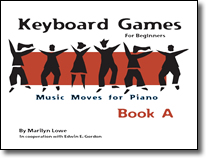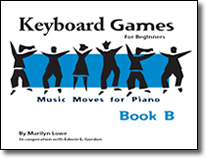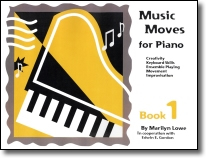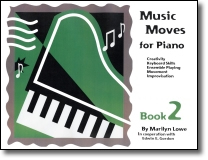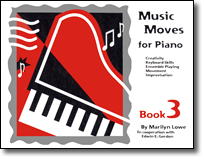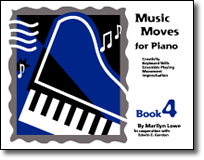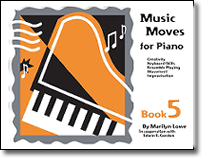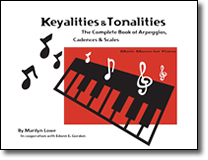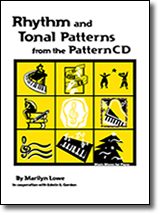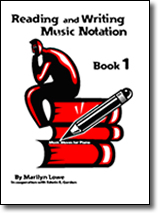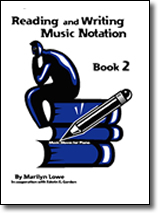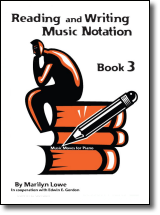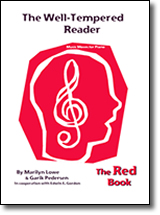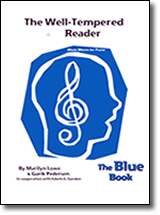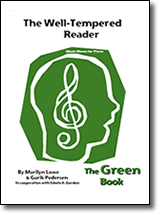Student Book Online Ordering
Keyboard Games Book A is designed for four-year old children, or as a first book for students of any age. The music in this book adds keyboard experiences to early childhood music and movement class activities.
Short keyboard pieces, in both duple and triple meters with duet parts, provide a kind of exploration using black and white piano keys. Improvisation and ensemble playing activities are included.
The online audio files include performances of the keyboard pieces, tonal and rhythm patterns for students to echo, and songs and chants for acculturation.
Keyboard Games Book B follows Book A with advancing keyboard materials in duple and triple meters with duet parts. Improvisation and ensemble playing are encouraged
Keyboard Games A and B provide a seamless transition from early childhood music activities to the more formal keyboard instruction provided in Student Book 1. This book may be used for any beginner along with Student Book 1.
The online audio files include performances of the keyboard pieces, rhythm and tonal patterns for students to echo, and songs and chants for acculturation.
Book 1 is for students of all ages, beginners and transfers. Students learn keyboard performance, improvisation, and audiation skills while they begin to acquire a music pattern vocabulary.
Transfer students become acquainted with singing, moving and chanting activities that help them learn how to play by ear, improvise, and arrange music.
Initially, game-like pieces introduce rhythm/meter concepts, ensemble playing, and technical skills. Students become familiar with the whole range of the keyboard.
The beginning pieces have teacher duet parts that are in different tonalities. These duet parts are simplifed for student performance. The pieces use both separated and connected styles of playing and use contrasting dynamics.
Following the introductory pieces, most of the performance pieces in Music Moves for Piano are from our rich folk song heritage.
Students learn to play in duple and triple meters and in major and minor tonalities. Students develop the left hand by playing the folk songs with each hand alone.
Accompaniments are added when a student feels comfortable coordinating two hands. Teachers and students are encouraged to adapt the suggested accompaniments to the physical capability of the student.
G Major, F Major, F-sharp Major, C Major and A Minor are introduced in Book 1.
Pattern instruction includes duple and triple meter macrobeat, microbeat, and division rhythm patterns and major and minor tonic and dominant tonal patterns.
Improvisation is the cornerstone of this audiation-based approach. Improvisation activities are included on the opening unit pages of the student books as well as in the Teacher's Lesson Plans book.
The online audio files include performances of the music,rhythm and tonal and patterns for students to echo, and songs to sing.
Book 2 continues with more difficult major and minor folk songs in duple and triple meters.
Students learn to play melody and accompaniment hands together. They also learn how to transpose and change tonality and meter.
Tonic and dominant accompaniments are in different styles to serve as model accompaniments. Students may learn these accompaniments or play a single-tone tonic/dominant accompaniment.
For many students a single-tone tonic/dominant accompaniment is learned most easily and efficiently. Single tone root accompaniments foster audiation of chord changes.
Improvisation activities are included in weekly lessons and assignments.
Pattern instruction includes duple and triple meter division and elongation rhythm patterns and major and minor tonic and subdominant tonal patterns.
Tonic and dominant arpeggios are introduced in C Major, A Minor, G Major, E Minor, F Major and D Minor. Students learn to play in E Major and C-sharp Minor.
The online audio files include performances of the music, rhythm and tonal patterns for students to echo, and songs to sing.
Book 3 becomes more of an audiation workbook to accompany the learning of piano repertoire.
Many new keyboard skills are presented. These skills are fundamental for advancing musically and technically. Students learn:
- Letter-names for all naturals, flats, sharps, and double sharps; that different letter-names can be used for the same piano key; and that the same letter-name can be used for different piano keys.
- Intervals on scale degrees using syllable names.
- Major triads on 12 piano keys and all major primary cadences.
- Minor triads on 12 piano keys and all minor primary cadences.
- Triads in three positions.
- Chromatics (half-steps) and whole-tones (whole-steps).
- Triads on major scale degrees.
- Articulation symbols.
- How to use the damper pedal.
Book 3 introduces more difficult major and minor folk songs in duple and triple meters. The emphasis is still on hearing chord changes and playing simple root-harmony.
Students now learn to play more difficult accompaniments and continue to transpose folk songs and to change tonality and meter of the folk songs.
Short improvisation activities are included in weekly lessons and assignments. These activities increase in variety and complexity.
Pattern instruction includes duple and triple meter rest, tie and upbeat patterns and major and minor tonic and subdominant tonal patterns.
D Major and B Minor, A Major and F-sharp Minor, and E major and C-sharp Minor are introduced. Students learn to play tonic/subdominant arpeggios and melodic cadences.
The online audio files include performances of the music, rhythm and tonal patterns for students to echo, and songs to sing.
Book 4 is a workbook for developing more advanced audiation skills while students learn increasingly difficult repertoire.
New improvisation, music notation, and keyboard skills help students grow in musicianship.
Dorian and Mixolydian tonalities are presented with their resting tones, characteristic tones, melodic cadences, and primary cadences.
Unusual meter song arrangements and chants expand the understanding of meter.
Students learn how to create melodic and rhythmic varations. Variation, three-part and rondo forms are introduced.
Students learn to play in A-flat Major and F Minor, E-flat Major and C Minor, and B-flat Major and G Minor.
The online audio files include performances of the music, rhythm and tonal patterns for students to echo, and songs to sing.
Book 5 is a workbook for developing more advanced audiation skills while students learn increasingly difficult repertoire.
New improvisation, music notation, and keyboard skills help students grow in musicianship.
Lydian, Phrygian, Aeolian and Locrian tonalities are presented with their resting tones, characteristic tones, melodic cadences, and primary cadences.
Combined meter and changing meter song arrangements and chants expand the understanding of meter.
Students learn how to create variations using retrograde, inversion, diminution, and augmentation.
7th, 9th, and 11th chords are introduced as well as the chromatic mediant.
Students learn to play in C-flat Major and A-flat Minor, E-flat Major and C Minor, and B-flat Major and G Minor.
The online audio files include performances of the music,rhythm and tonal patterns for students to echo, and songs to sing.
Keyalities and Tonalities: The Complete Book of Arpeggios, Cadences & Scales
Organized by keyality, this book is an encyclopedia for students to help in mastering all major and minor keyalities.
Other tonalities are represented by identifying the characteristic tone, melodic cadence, and harmonic cadence for each tonality (or mode).
Rhythm and Tonal Patterns from the Pattern CD is a print-out of all the patterns on the Pattern CD. One section is without syllables (for students) and another section is with syllables (for teachers).
This book is an essential companion to the Reading and Writing Music Notation books.
Reading and Writing Book 1 guides students in applying their pattern vocabularies to notation in a variety of projects.
Projects include: reading, writing, performing, music analysis, transposition, and composition.
Students are ready for this book after they are well into Student Book 3.
The workbook follows the sequenced content of the Pattern CD.
Reading and Writing Book 2 guides students in applying more advanced pattern vocabularies to notation in a variety of projects.
Projects include: reading, writing, performing, music analysis, transposition, and composition.
Students are ready for this book after they have finished Reading and Writing Book 1.
The workbook follows the sequenced content of the Pattern CD.
Reading and Writing Book 3 guides students in applying more advanced pattern vocabularies to notation in a variety of projects.
Projects include: reading, writing, performing, music analysis, transposition, and composition.
Students are ready for this book after they have finished Reading and Writing Book 2.
The workbook follows the sequenced content of the Pattern CD.
The three Well-Tempered Reader books are not sequential but are organized by relative major and minor keyalities. There are five pieces in each keyality/tonality.
The books include late elementary level repertoire from the Baroque and Classical periods of music.
Using an analysis form and a sequential thinking process, students learn how to study new music efficiently through the application of audiation skills. The learning process is the same as that used for learning songs to sing and performance pieces in the Student Books.
The 'red' book includes: E Flat Major, C Minor, C Major, A Minor, C Flat Major, A Flat Minor, B major, b Flat Major, and G Minor.
The three Well-Tempered Reader books are not sequential but are organized by relative major and minor keyalities. There are five pieces in each keyality/tonality.
The books include late elementary level repertoire from the Baroque and Classical periods of music.
Using an analysis form and a sequential thinking process, students learn how to study new music efficiently through the application of audiation skills. The learning process is the same as that used for learning songs to sing and performance pieces in the Student Books.
The 'blue' book includes: D Major, B Minor, F Major, D Minor, F Sharp Major, G Major, E Minor, G Flat Major, E Flat Minor.
The three Well-Tempered Reader books are not sequential but are organized by relative major and minor keyalities. There are five pieces in each keyality/tonality.
The books include late elementary level repertoire from the Baroque and Classical periods of music.
Using an analysis form and a thinking sequential process, students learn how to study new music efficiently through the application of audiation skills. The learning process is the same as that used for learning songs to sing and performance pieces in the Student Books.
The 'green' book includes:A Major, F Sharp Minor, A Flat Major, F Minor, C Sharp Major, E Major, C Sharp Minor, D Flat Major, B Flat Minor
Upcoming Events
26 January 2026
- Musicianship and Keyboard Activities in Aeolian Tonality 12:00 to 01:00 Online here
23 February 2026
- Musicianship and Keyboard Activities in Lydian Tonality 12:00 to 01:00 Online here
30 March 2026
- Musicianship and Keyboard Activities in Phrygian Tonality 12:00 to 01:00 Online here
27 April 2026
- Musicianship and Keyboard Activities in Locrian Tonality 12:00 to 01:00 Online here
18 May 2026
- Musicianship and Keyboard Activities in Uneven meters 12:00 to 01:00 Online here
15 June 2026
- Musicianship and Keyboard Activities in Everything 12:00 to 01:00 Online here
Online Resources
Podcasts
- Introduction to Audiation-based Piano Instruction and Music Moves for Piano (for new teachers or those interested in learning more)
- Music Moves for Piano Teachers (for current teachers)
Learning Opportunities
Video Podcasts
Tim Topham Interview
About MLT-Piano-based instruction. Click here to view.LIVESTREAM TEACH FOR GROWTH with Nguyễn Ngân
Music Moves for Piano and Edwin E. Gordon's Music Learning Theory. Click here to view.Musical U Team
Mind Before Fingers, with Marilyn White Lowe. Click here to view.MMTA Exclusive
Music Moves for Piano: An Audiation-Based Piano Method Click here to view.Follow Us
Sales Support
Printed books can also be ordered via our distributors:
Digital Sales of Teacher Books/Resources available at: Digital Sales
Please report any incorrect links or non-order related questions to sales@musicmovesforpiano.com
